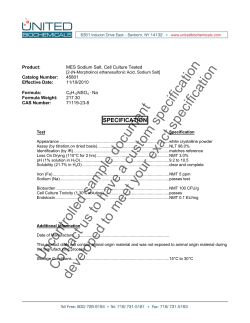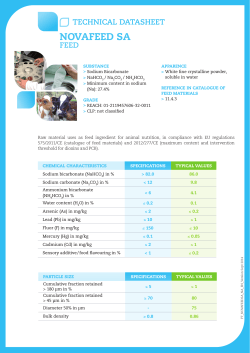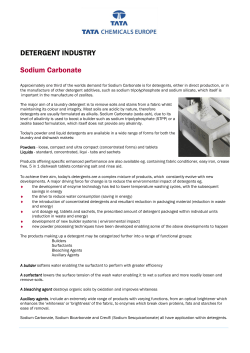
0: Honors Chemistry Name: Review for Midterm Class
Page 1 of 14 0: Honors Chemistry Review for Midterm Name: Class: Date: BONDING 1. Consider the following chemical formulas: NaCl, H2O, and N2. For each formula, a. Draw the Lewis dot structure. b. Label each Lewis dot structure as polar covalent bond, nonpolar covalent bond, or ionic bond. Include evidence for each label. c. Identify the VSEPR shape of any covalent molecules. 2. Complete the table below about bonding theories. Bonding Type Types of Atoms in Bond Behavior of Electrons Metal and a nonmetal (or a polyatomic ion) Metallic Electrons are shared EQUALLY in a single, double, or triple bond. Nonmetals Page 2 of 14 3. Using the chart below, identify the bonding type of each substance. Justify your answer. Physical Properties of Substances A, B, and C Solubility in a… Substance Nonpolar Conductivity Polar Solvent Melting Point Boiling Point (solids) Solvent (as a solid) A Yes No No High High B No Yes No Low Low C No No Yes High High A: B: C: 4. Use the electronegativity difference to determine if the bond type. Element A Element B Electroneg. A Electroneg. B Difference Ca Cl C H O O Bond Type 5. Based on the types of atoms, predict if each pair of atoms will form an ionic, metallic, or covalent bond. Element A Element B Atom Type A Atom Type B Bond Type Fe O Na Mg O O Page 3 of 14 6. Use the electron sea to explain the properties of metals. 7. Explain what happens to a metal when it combines with a nonmetal, in terms of electrons. 8. Why do ionic compounds conduct when dissolved in water, but not as solids? Draw a picture to explain and provide an example of such a compound. 9. What is meant by the phrase “like dissolves like”? 10.Determine the VSEPR shape of the following: a. CH4 b. H2S 11.What do the “dots” in a Lewis dot structure represent? Page 4 of 14 NAMING AND FORMULA WRITING 12.Complete the table below by writing in the bonding type, and the name or formula as needed. Ionic, Covalent, Name Formula or Acid? A Sodium Carbonate B C P4O10 Phosphorous Acid D E FeSO4 Perchloric Acid F G H2CrO4 Cobalt (II) bromide H I LiC2H3O2 Copper (III) sulfate J K L HCN Aluminum hydroxide Cu3PO4 Page 5 of 14 13.For each of the following, determine if the formula is correct or incorrect. If incorrect, change the formula so that it is correct. a. CaCl b. NH4NO3 c. H2CN d. NaCrO4 e. Ca(OH)2 f. BaHCO3 14.The following name/ formula pairs are incorrect. Change the formula so that the pair is correct. a. CaBr, Calcium bromide b. BaSO4, barium nitrate c. FeCl2, Iron (III) chloride d. CS, carbon disulfide e. KNO2, Potassium nitrate f. H2SO4, hydrosulfuric acid Page 6 of 14 CHEMICAL REACTIONS 15.Explain the law of conservation of mass. How does a balanced chemical equation illustrate this principle? 16.Identify the number of each type of atom in the following formulas. a. Ca3(PO4)2 b. C3H5(OH)3 c. (NH4)2CrO4 17.Write the balanced chemical equation and indicate the type of reaction. a. ___ N2 + ___O2 ___NO b. Solid baking soda (sodium bicarbonate) is heated, forming carbon dioxide gas and solid sodium oxide. Page 7 of 14 c. ___ FeCl3 + ___ NaOH ___ Fe(OH)3 + ___NaCl d. Sodium phosphate and calcium chloride react to form calcium phosphate and sodium chloride. e. ___C3H8 + ___O2 ___CO2 + ___H2O 18.Use the experimental data below to construct an activity series. A(NO3)2 B(NO3)2 C(NO3)2 D(NO3)2 A -NR Reaction Reaction B Reaction -Reaction Reaction C NR NR -NR D NR NR Reaction -- Page 8 of 14 19.Based on the activity series you constructed, which metals (X) will replace metal D in the chemical reaction below? X + DCl2 XCl2 + D 20.Complete the table below about the different types of reactions. Type of Reaction General Equation Explanation A + B AB Decomposition A lone element replaces a less reactive element in a compound Double Replacement CxHyOz + O2 CO2 + H2O Page 9 of 14 PERIODIC TRENDS 21.Color code the table of elements below to show metals (blue), nonmetals (green), and metalloids (red). 22.Which elements are diatomic? 23.Summarize the properties of metals, nonmetals, and metalloids. Conductivity Malleability Appearance Metal Nonmetal Metalloid 24.Give examples of elements in the same… a. Family: b. Series: Page 10 of 14 25.Complete the table about family names on the periodic table. Family Name Column 26.Halogens have very high ionization energy. Explain why. Alkali Metals 18 Halogens 2 27.Explain how and why each of the periodic trends change as you move across a series or down a group. Trend Across a Series Down a Group Electronegativity Atomic Size/ Radius First ionization energy Shielding Effect Page 11 of 14 SUBATOMIC PARTICLES 28.Complete the table about subatomic particles. Particle Charge Location Proton Mass (heavy or light) Neutron Electron 29.Which subatomic particle is responsible for the chemical properties of an atom? 30.Complete the following table. Symbol Atomic # Protons 23 +1 A Na 11 B 20 C 20 D 11 Neutrons Electrons 21 20 20 12 Mass # 40 11 a. What is an isotope? Circle the isotopes in the table above. b. Which has more electrons Fe0, Fe+2, Fe+3, or Fe+5? 31.Complete the picture showing the results of Rutherford’s experiment, then write a brief explanation of what is happening. 32.Describe what happens when an electron absorbs and reemits energy. Page 12 of 14 EXPERIMENTAL METHODS 33.Students wanted to determine how the amount of sodium affected the amount of energy given off during the reaction of sodium with water. They measured out 1 gram, 2 grams, 3grams, and 4 grams of sodium metal, and added each to 500 mL of water. The amount of energy given off was then recorded into the table below. The Effect of Mass of Sodium on the Amount of Energy Released Amount of water (mL) Mass of sodium (g) Energy released (kilojoules) 500 1 12.6 500 2 25.2 500 3 38.1 500 4 48.9 a. What is the independent variable? b. What is the dependent variable? c. What is a constant in the experiment above? d. What is a possible question the students were trying to answer during this experiment? e. What did the students use to measure out the sodium? f. What did the students use to measure out the water? g. Which reactant contained only one type of atom? Page 13 of 14 INTERMOLECULAR FORCES 34.Consider the two molecules below. a. Identify which IMFs are present in each molecule. b. The boiling point of H2O is 100°C, while the boiling point of H2S is -60°C. Use IMFs to explain the difference in boiling points for these otherwise similar molecules. 35.Which molecule is more likely to have a strong odor? Explain. Page 14 of 14 MOLE CALCULATIONS 36.Explain what Avogadro’s number is – what do we use it for? 37. Setup and solve the following mole conversions. a. How many moles are in a 35 gram sample of sodium chloride? b. How many molecules are present in 15 L of carbon dioxide? c. How many grams are in 2 moles of sodium atoms? d. How many grams are present in 1.204x1024 atoms of iron? 38.Explain why a mole of silver and a mole of gold have the same number of atoms, but different molar masses. 39.Find the percent by mass of oxygen in each of the following. a. KMnO4 b. H2O c. CaO
© Copyright 2025





















